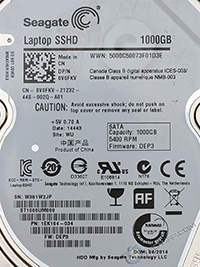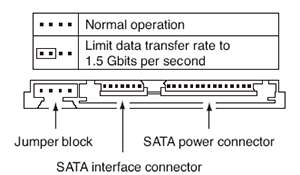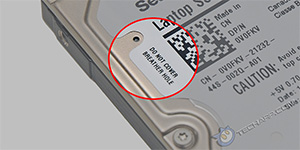The Seagate Laptop SSHD
The Seagate Laptop SSHD looks like any other 2.5" mobile hard drive, with a label on the top plate and an uncovered PCB on the underside. It even has the same heft. It's actually slightly heavier than the typical 2.5" hard disk drive (115 g, instead of 110 g), but you wouldn't have noticed the difference.
The label on the Seagate Laptop SSHD has a lot of important information, like the hard drive model, storage capacity and serial number. There are also interesting details like its date and place of manufacture. This particular drive was manufactured in Wuhan, China on the 29th of April, 2014.\
For the geeks, the date is listed as 14443. That's Seagate's date code (YYWWD), where YY is the fiscal year (beginning on the 1st Saturday of July), WW is the fiscal week (from the 1st Saturday of July) and D referring to the days from beginning of the week (which runs from Saturday to Friday).
 |
 |
 |
Do note that this is an Advanced Format drive so it will suffer performance penalties if its partitions are not properly aligned. This is only a problem if you're using an older operating system like Windows XP or Windows 98. The best method is to use the Seagate DiscWizard utility to prepare the drive, but failing that, the drive comes with SmartAlign Technology, which reduces the performance penalty.
Advanced Format Technology
Seagate use the Advanced Format Technology (AFT) to help achieve the areal density necessary to create the 500 GB platters used in this hard disk drive. However, AFT has some effect on performance.
By allowing for a higher areal density, AFT will boost a drive's sequential transfer rate, while the tighter spatiality of the data blocks improves sequential seek times. The larger ECC block will not only improve data integrity, it will also allow for faster error checking and correction for the same amount of data.
When used with operating systems that have native support for Advanced Format Technology, the larger sector size will reduce the command overhead as fewer commands are needed to transfer the same amount of data. However, we will only see this benefit in future AFT drives that do not use the 512-byte emulation mode.
The Seagate Laptop SSHD uses the 512-byte emulation mode for compatibility reasons. This actually incurs a significant performance penalty, which we have dubbed as the "Advanced Format effect". To counter this effect, Seagate uses a large 64 MB SDRAM buffer. This is a dual-purpose buffer - it is used not only to improve the performance of the hard disk drive, it's also used to buffer and combine multiple writes to reduce excessive writes to the solid state cache.
Finally, data accesses that are less than 4,096 bytes in size will incur some performance penalty. This is because the Advanced Format drive will read the entire 4 KB sector even if you only needed a single byte. The good news is that in this day and age of files that run into tens, if not hundreds of megabytes, such small accesses are uncommon.
For more details on Advanced Format Technology and the "Advanced Format effect", take a look at The Western Digital Advanced Format Performance Comparison Guide.
Adaptive Memory Technology
 The Seagate Laptop SSHD has 8 GB of MLC NAND flash memory that serves as the solid state cache. The relatively small storage capacity is necessarily to limit cost, but it also limits the amount of data that can be stored inside. This is where Seagate's Adaptive Memory Technology comes in.
The Seagate Laptop SSHD has 8 GB of MLC NAND flash memory that serves as the solid state cache. The relatively small storage capacity is necessarily to limit cost, but it also limits the amount of data that can be stored inside. This is where Seagate's Adaptive Memory Technology comes in.
The crux of the Adaptive Memory Technology is a set of algorithms that allow the SSHD's controller to track your data usage patterns, so it can identify and determine which data should be stored in the faster solid state cache. It does all the tracking and prioritization internally, without influence from the host (computer), applications or storage device drivers.
Although frequently-used data are naturally prioritized for storage in the solid state cache, the Adaptive Memory Technology can differentiate the different data elements to ensure that only those that benefit from storage in the solid state cache (e.g. data elements associated with booting, restarting and hiberting the computer) will be transferred there. Other data elements, especially video and audio files, will be ignored. Doing so maximizes the effectiveness of the solid state cache.
Jumpers & Connectors
This is a Serial ATA hard drive, with native support for SATA 6 Gb/s. However, it is backward-compatible so you will have no problem using it with older SATA 1.5 Gb/s controllers. The faster SATA 6 Gb/s interface is really overkill since the Seagate Laptop SSHD only boasts a maximum sustained internal (platter-to-buffer) transfer rate of 100 MB/s. Even its solid state cache isn't much faster at about 115 MB/s.
Like all Serial ATA drives, it comes the standard SATA data (left) and power (right) connectors and is hot-pluggable. That means you can connect and disconnect this hard disk drive to your PC while it's still running.
 |
 |
There is a jumper block next to the SATA connectors but there's no need to use it. The sole setting of limiting the data transfer of SATA 1.5 Gb/s is only necessary if you are using the SSHD with certain (old) SATA controllers that do not properly implement the SATA 3.0 Gb/s speed negotiation, like the VIA VT8237 and VT8237R south bridge chips.
Breather Hole
 |
The Seagate Laptop SSHD has a marked breather hole on the upper plate, right above the headstack. Do not cover this hole.
Breather holes allow condensation inside the hard drive to escape. They also equalize the hard drive's internal pressure with the ambient air pressure.
The hard disk drive needs them to function properly, so please make sure you do not occlude this hole, or any other hole you may see.
| If you like this article, please share it! -> |
Support Tech ARP!
If you like our work, you can help support out work by visiting our sponsors, participate in the Tech ARP Forums, or even donate to our fund. Any help you can render is greatly appreciated!
Support us by buying from Amazon.com! |
|
| Grab a FREE 30-day trial of Amazon Prime for free shipping, instant access to 40,000 movies and TV episodes and the Kindle Owners' Lending Library! | |
<<< Introduction, Specs Comparison, Packaging : Previous Page | Next Page : Testing The Seagate Laptop SSHD, Usable Capacity, Max Surface Temperature, Disk Transfer Rate, Platter Profile >>>







 Add to Reddit
Add to Reddit
